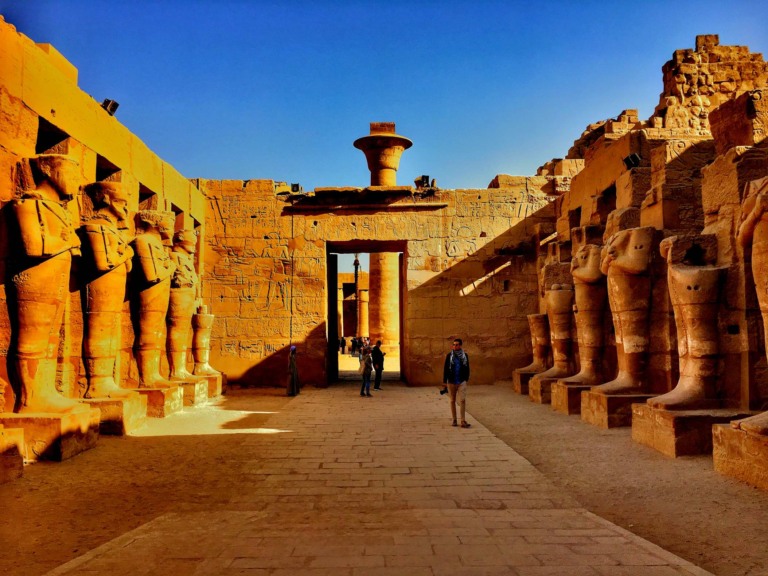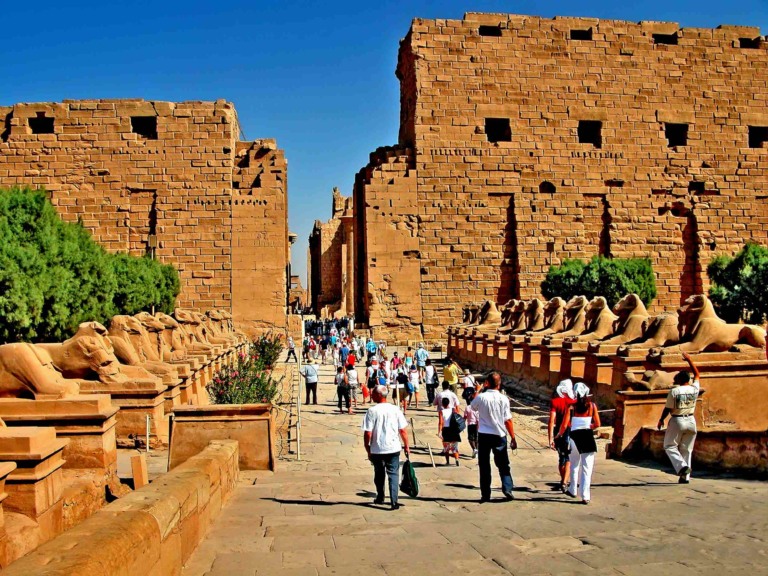The Khonsu Temple, located in the southwest corner of the Karnak Temple complex in Luxor Governorate, Egypt, is a remarkable archaeological site dedicated to the deity Khonsu, the son of Amun and Mut. This temple stands in confrontation with Luxor Temple and is connected to it by a recently revealed avenue of sphinxes. Here’s a detailed overview of the Khonsu Temple:
Khonsu Temple Facts
1. Founding and Dedication: The Khonsu Temple, constructed during the reign of Ramses III (approximately 1186–1155 BC), was primarily built to honor Khonsu, the moon god and a member of the Theban triad, which includes his parents, Amun and Mut. Ramses III undertook the construction of this temple by demolishing a previous structure that occupied the site, utilizing some of its stones in the new temple’s construction.
2. Architectural Features: Despite its relatively modest size, measuring about 70 by 30 meters (230 by 99 feet), the Khonsu Temple exhibits impressive architectural precision. It consists of several key components, including a pylon (an ornamental gateway), a courtyard, a hypostyle hall (a hall with columns), a barque shrine (a sacred boat shrine), an ambulatory (a covered walkway), and several chapels, with one located on the roof.
Carvings in both bas-relief (raised) and intaglio (engraved) adorn nearly every surface of the temple. The architectural features of the Khonsu Temple include a peristyle court and a portico with twenty-eight columns on each side. The temple’s complete pylon stands at a length of 113 feet (34.5 meters) and a height of 59 feet (18 meters), featuring four grooves for masts with banners. In front of the pylon are remnants of a colonnade guarded by sphinxes.
Temple of Amun Mut Khonsu
3. Building Materials: The temple’s construction involved the use of various types of stone. While most of the temple is constructed from sandstone, the interior of the barque shrine is made of granite. Some of the sandstone blocks were repurposed from earlier structures, including temples on Luxor’s west bank.
4. Significance of Khonsu: Khonsu was a lunar deity depicted as a man with a falcon head and a crescent moon atop his head. Sometimes, he appeared as a baboon, similar to the moon god Thoth. Khonsu was believed to have the power to ward off evil spirits and was revered for his healing abilities, and there are historical accounts of his statue being sent by Ramses II to aid a sick child in Syria.
5. Temple Layout: The Khonsu Temple is designed with a peristyle court and a portico featuring twenty-eight columns on each side. It includes a hypostyle hall connected to a sanctuary for the barque of Khonsu. Chapels flank the hall, and a staircase provides access to the temple’s roof.
6. Restoration and Preservation: The temple’s colorful and well-preserved relief carvings, some of which were concealed by centuries of dirt and smoke, are considered among the finest at Karnak. Efforts have been made to restore and protect these invaluable carvings.
Temple of Khonsu at Karnak
7. Historical Additions: The temple’s hypostyle hall, built by Nectanebo I, is relatively small in size. Inside, two baboon carvings resembling those from the time of Seti I were discovered, likely originating from the previous structure on the site. Numerous blocks within the temple display decorations that are either mismatched or reversed, providing evidence of the extensive reuse of materials from nearby temple complexes, especially during the Ptolemaic era.
Over the centuries, various additions and modifications were made to the temple. During the Ptolemaic period, Ptolemy III Euergetes constructed a large gate and a protective wall around the temple. Although only the gate remains, it is a testament to the temple’s historical significance.
8. Contributions by Different Rulers: The Khonsu Temple’s construction and development were not limited to Ramses III. Several subsequent rulers, including Libyan generals who reigned as kings of Upper Egypt, contributed to its completion and expansion.
9. Rediscovery: The temple’s significance was rediscovered when well-preserved and vibrant relief carvings were revealed beneath layers of grime and soot. These carvings provide valuable insights into the culture and history of ancient Egypt. Hidden within the Khonsu Temple for many centuries were some of the best-preserved and most colorful relief carvings at Karnak.
These carvings were concealed by layers of smoke and dirt. The temple’s entrance lies at the end of the sphinx-lined road leading to Luxor Temple. During the Ptolemaic period, Ptolemy III Euergetes constructed a significant gate and wall around the temple, with only the gate remaining today. Herihor, an officer in the Egyptian army and the High Priest of Amun in Thebes during the time of Pharaoh Ramesses XI, added inscriptions to the temple’s front.
10. Modern Access: Today, the Khonsu Temple is accessible to visitors as part of the Karnak Temple Complex. Tourists can explore its various chambers and admire the detailed carvings that shed light on ancient Egyptian religious practices and beliefs. The Khonsu Temple stands as both an architectural marvel and a historical treasure, offering a glimpse into the rich religious and cultural heritage of ancient Egypt.






